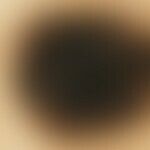Synonym(s)
irregular extensions; irregular foothills; pseudopodia at the periphery; pseudopods
DefinitionThis section has been translated automatically.
Peripheral tumor outgrowths projected into the incident light plane, pointing radially, are bulbously thickened at the ends, multi-fingered, laterally bent and sometimes tree-like.
General informationThis section has been translated automatically.
Incident light microscopy: The peripheral tumor extensions, which are thickened at the ends and finger-shaped, are blue-grey or brown-grey in colour. In inflammatory neoplastic vascular reaction the pseudopodia are surrounded by a red rim.
You might also be interested in
OccurrenceThis section has been translated automatically.
In the group of pigment cell tumors, the specificity of this reflected light microscopic feature for malignant melanomas is over 90%, the sensitivity is 18%. Occasionally, spindle cell nevi show the phenomenon.
HistologyThis section has been translated automatically.
Confluent junctional melanocyte nests proliferate peripherally into the papillary stratum and into the border area of the reticular stratum. Partially strong transepidermal pigment discharge.
LiteratureThis section has been translated automatically.
- Bahmer FA, Fritsch P, Kreusch J, Pehamberger H, Rohrer C, Schindera I, Smolle J, Soyer HP, Stolz W (1990) Diagnostic criteria in reflected light microscopy. Dermatologist 41: 513-514
- Kreusch J, Rassner G (1990) Structural analysis of melanocytic pigment moles by reflected light microscopy. dermatologist 41: 27-33






